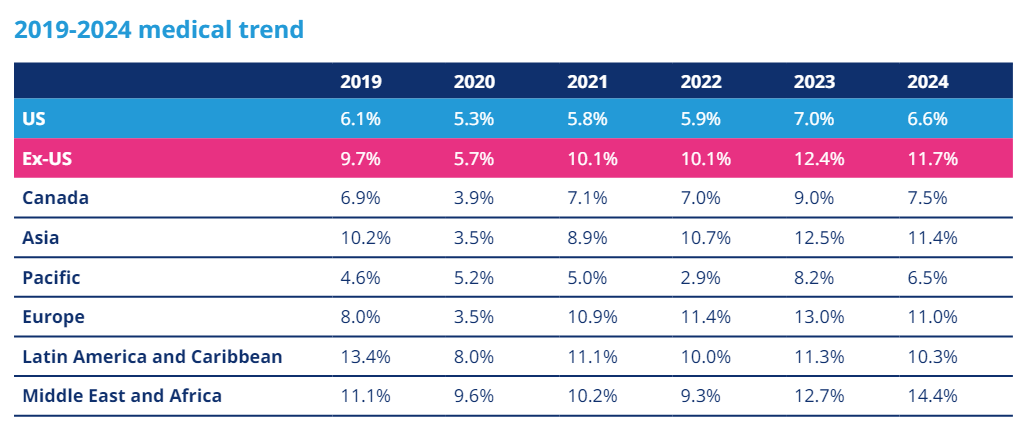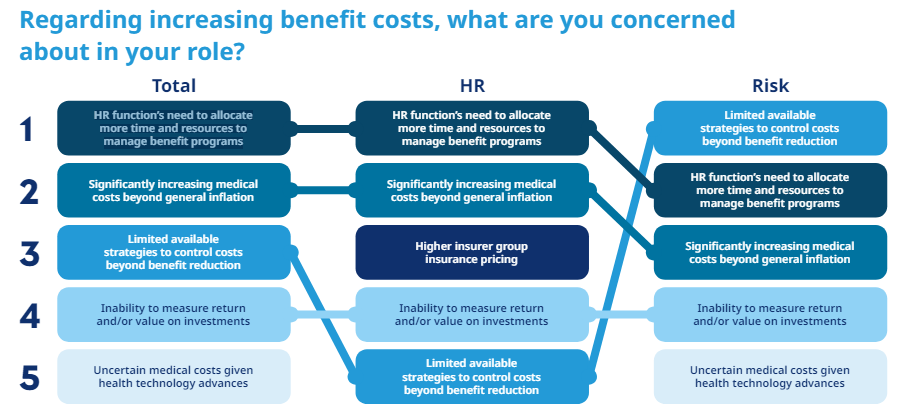'The top 10 risks for HR professionals are dominated by talent, leadership and workforce practice concerns, such as labour shortages'

Increasing health and benefit costs is the top people risk for employers in Canada.
This is consistent with the global data, according to a report from MercerMarsh.
“Both HR and risk professionals view increasing health and benefits costs as their most pressing concern. This is driven by its high likelihood, as its severity score is further down the list,” says the report.
Healthcare costs are also expected to remain high in coming years. For 2024, the year-over-year cost increase for claims under the medical scheme on a per-person basis in Canada is expected to be 7.5 per cent.
“This is an ongoing concern for senior leaders, with one in four executives in Mercer’s Global Talent Trends 2024 report saying that combating increased health and benefit costs will have the most impact on their business in 2024,” said MercerMarsh.
“But while the likelihood of increased benefits costs is high, its severity is low in comparison (ranked 11th). That is reflected in CEOs’ thinking, with just 12% believing that rising healthcare costs will influence their three-year plans.”

Source: Mercer
Globally, HR function’s need to allocate more time and resources to manage benefit programs is also the top concern for HR professionals.
The average medical costs increase for 2024 is expected to be lower compared with the increase in 2023, according to a previous report.

Source: Mercer
Top 10 people risks in Canada
Overall, the top 10 people risks for employers in Canada are:

Source: Mercer
“The top 10 risks for HR professionals are dominated by talent, leadership and workforce practice concerns, such as labour shortages,” says MercerMarsh.
“Risk professionals place a slightly greater focus on technological change and business disruption.”
The top 10 rankings also reveal some “key blind spots” for both HR and Risk professionals, says the report, “such as the deepening impact of weather-related events and natural disasters on parts of the workforce, as well as the relationship between health concerns such as chronic illnesses and increased health and benefit costs.”
Employers should be mindful of how much they are putting into their group benefits plans for employees for 2024, according to insurance advisors. Overall, 56 per cent of advisors say that balancing costs and enhancements to their benefits plans should be the top priority for employers, reports The Empire Life Insurance Company.
Risks to mental health, talent, tech
When it comes to risks associated with health, wellbeing and safety, Canadian employers fear that insufficient employer-provided emotional well-being programs (30 per cent) and “unsustainable” workloads (32 per cent) will keep employees from being productive.
Also, they are concerned that employers’ inability to handle employee mental health issues (33 per cent) and concerns (28 per cent) could increase absenteeism and/or disability claim costs, said MercerMarsh.
Meanwhile, employers are concerned that people risks associated with talent, leadership and workforce practices could results in:
- inability to motivate workforce towards a unified organizational vision and purpose (38 per cent)
- significant dependencies on key people and inadequate succession planning (37 per cent)
- negative organizational culture or work environment, tense team dynamics and mistrust (36 per cent)
As for risks associated with technological change and disruption, these include:
- the pressure to provide higher pay and levels of benefits to compete for technology talent and skill (45 per cent) and an increased risk of cyber-attacks specifically due to the lack of skilled cyber expertise (40 per cent)
- employees’ over-reliance and complete trust in AI generated content without proper verification (39 per cent)
- The inability to upskill/reskill talent to meet the changing needs (32 per cent).




